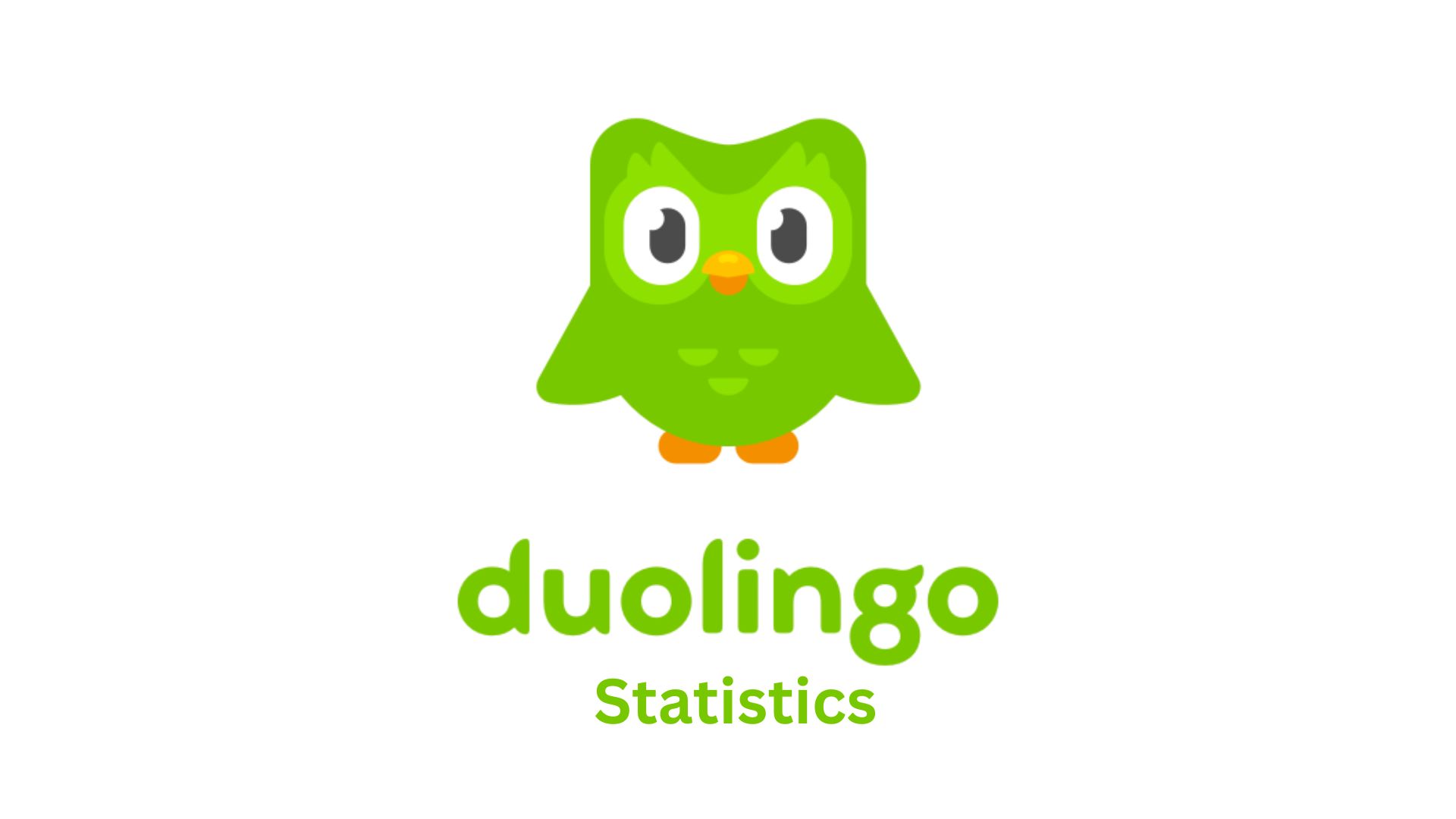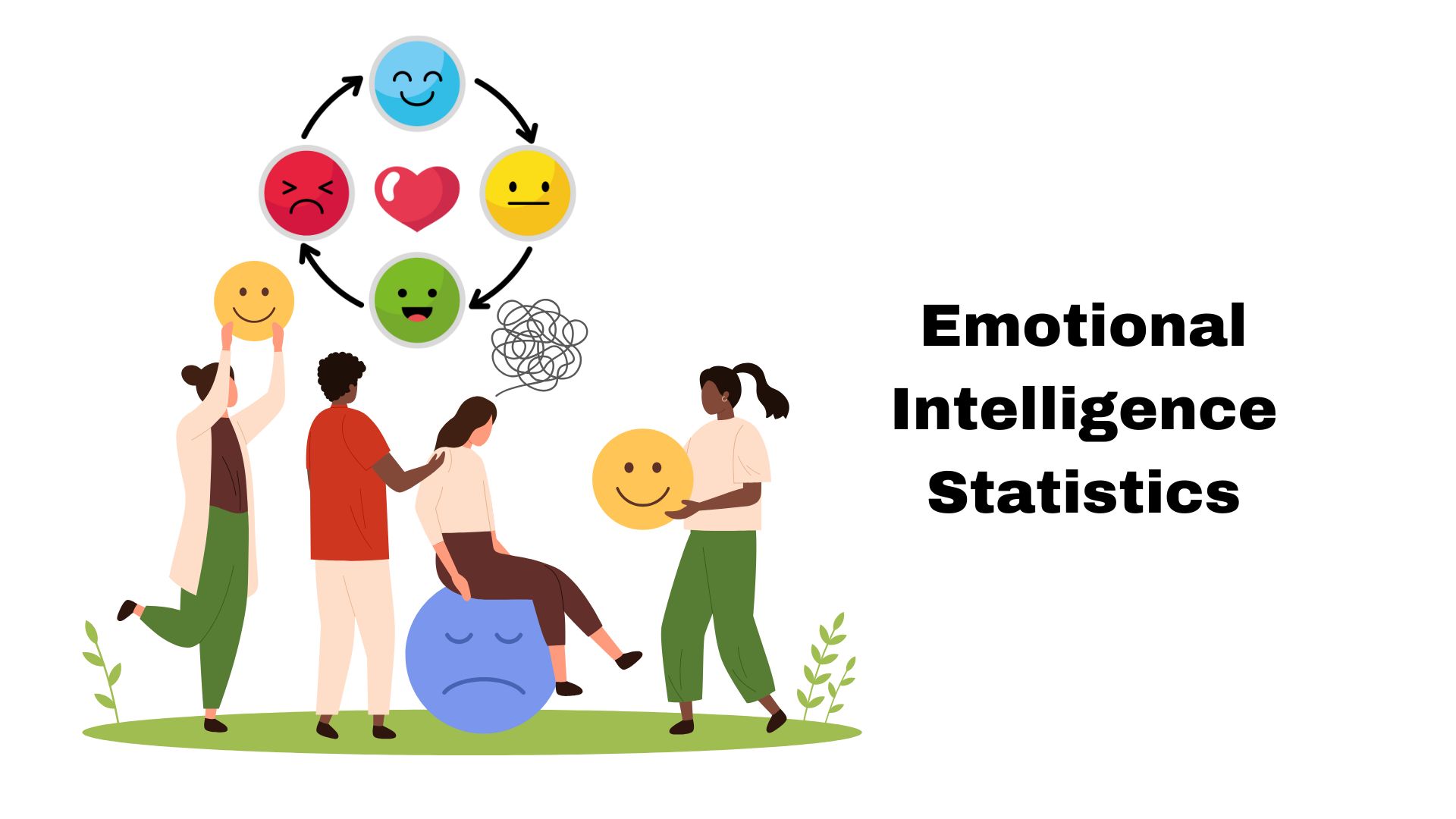Apple Music Statistics And Facts (2025)
Updated · Oct 20, 2025
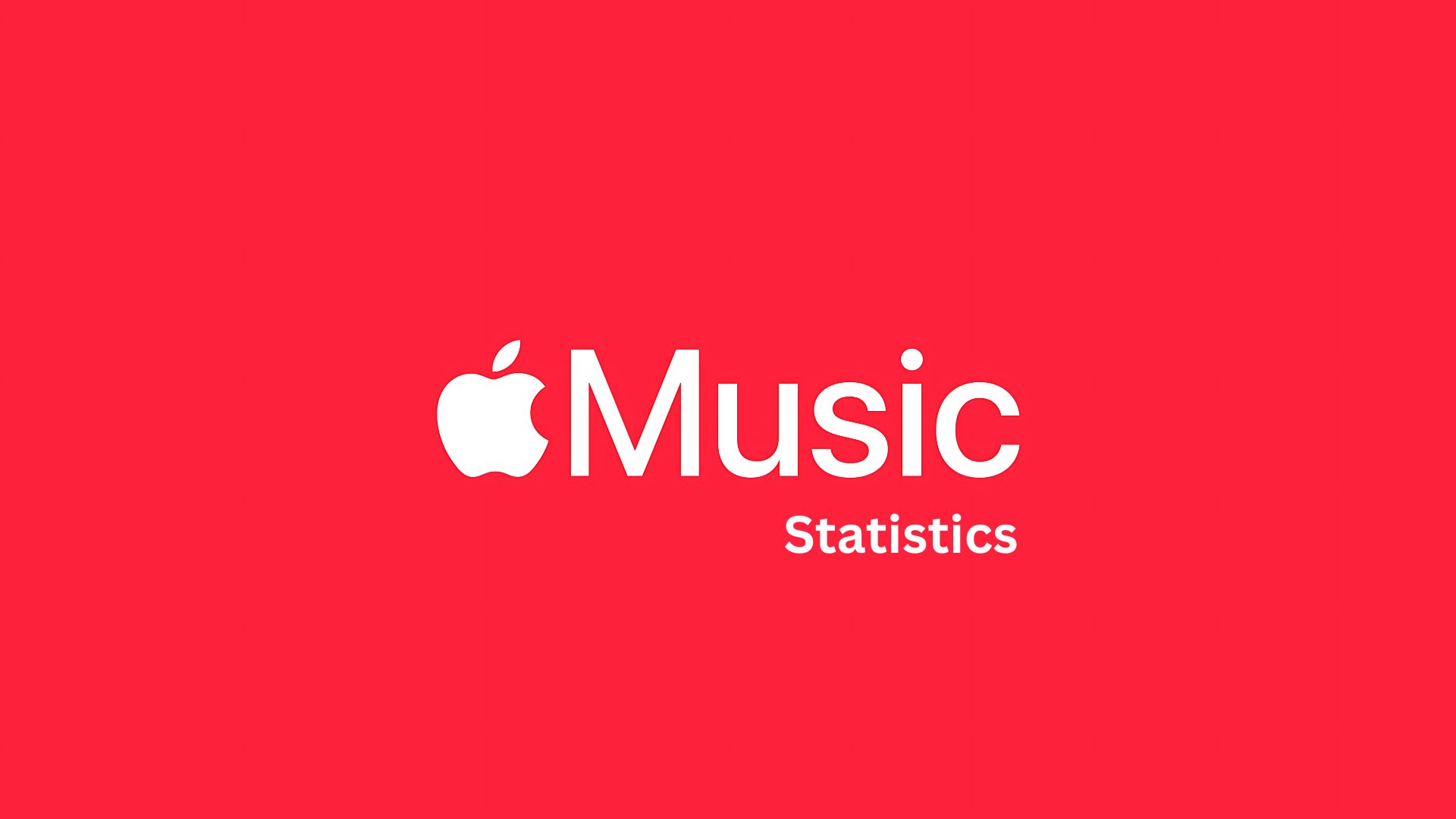
Table of Contents
- Introduction
- Editor’s Choice
- Apple Music Revenue
- Leading Apple Apps By Downloads
- Global Audio Streaming Platforms Service Subscription Search
- Apple Music Global Subscribers
- Popular Online Music Brands
- Apple Music Users By Country & Region
- Apple Music’s Most Streamed Artist
- Apple Music Business Statistics And Facts
- Apple Music Users By Age
- Apple Music Market Share
- Conclusion
Introduction
Apple Music Statistics: Apple Music was instituted in 2015 and has earned itself one of the fastest-growing music streaming platforms in the world. By the year 2024, it will be strongly placed in the fields of the industry due to a great library of songs, features, and increasing subscribers.
This article examines the most important Apple Music statistics and events to comprehensively highlight its influence and growth.
Editor’s Choice
- According to Apple Music statistics, with revenue increasing from US$1.7 billion in 2016 to US$9.2 billion in 2023, the 2018-2023 period can be said to have witnessed significant market growth and investments in user experience.
- In July 2024, Shazam was the most downloaded app published by Apple, earning 4.6 million downloads, followed by Move to iOS at 3 million and TestFlight at 1.66 million.
- For quite some time, searches for Apple Music have remained the highest for music subscription queries, indicating that consumers are interested in the platform.
- As of June 2023, Apple Music has around 93 million subscribers, making it the second-largest streaming platform after Spotify.
- In America, Spotify accounts for 35% of usage, making it the most popular streaming service, followed by YouTube Music at 19% and Apple Music at 14%.
- Regional differences in Apple Music usage can be observed with North America having the highest %age of Premium subscribers (59%) while the rest of the regions have higher free users.
- Taylor Swift is the most-streamed artist on Apple Music, with over 70 million streams, followed closely by Ed Sheeran and Drake.
- In 2020, Apple Music expanded to include 52 new countries, making it free to more regions in the world.
- Apple Music statistics reveal that, the age diversity of Apple Music includes the biggest user population at the age of 25-34 and older than 55 (both at 23%).
- Spotify continues to lead the music streaming market with 36% of subscribers, followed by Apple Music (30.7%), Amazon Music (23.8%), and YouTube Music (6.8%).
Apple Music Revenue

(Reference: demandsage.com)
- Since its inception, Apple Music has enjoyed a steady increase in revenues, reflecting a steady gain in market share in the music streaming sector.
- Starting in 2016 with revenues of US$1.7 billion, the platform had entered its early stage of expansion.
- In 2017, revenues swelled to US$2.3 billion, showing a significant rise with a gain in subscribers on Apple Music. The upward trend continued in 2018, as revenues climbed to US$3.5 billion, to US$4.4 billion in 2019.
- In subsequent years, the growth was even greater, with revenues rising to US$6.3 billion in 2020 when demand for global music streaming surged. This pace carried forward in 2021 as revenues touched US$7 billion on Apple Music and further up to US$8.3 billion in 2022.
- The latest numbers from 2023 testify to revenues of US$9.2 billion and yet another year of steady growth.
- Apple Music statistics represent the strength of the market presence from Apple Music, its growth strategies, and constant investments in user experience, exclusive content, and innovative features.
Leading Apple Apps By Downloads
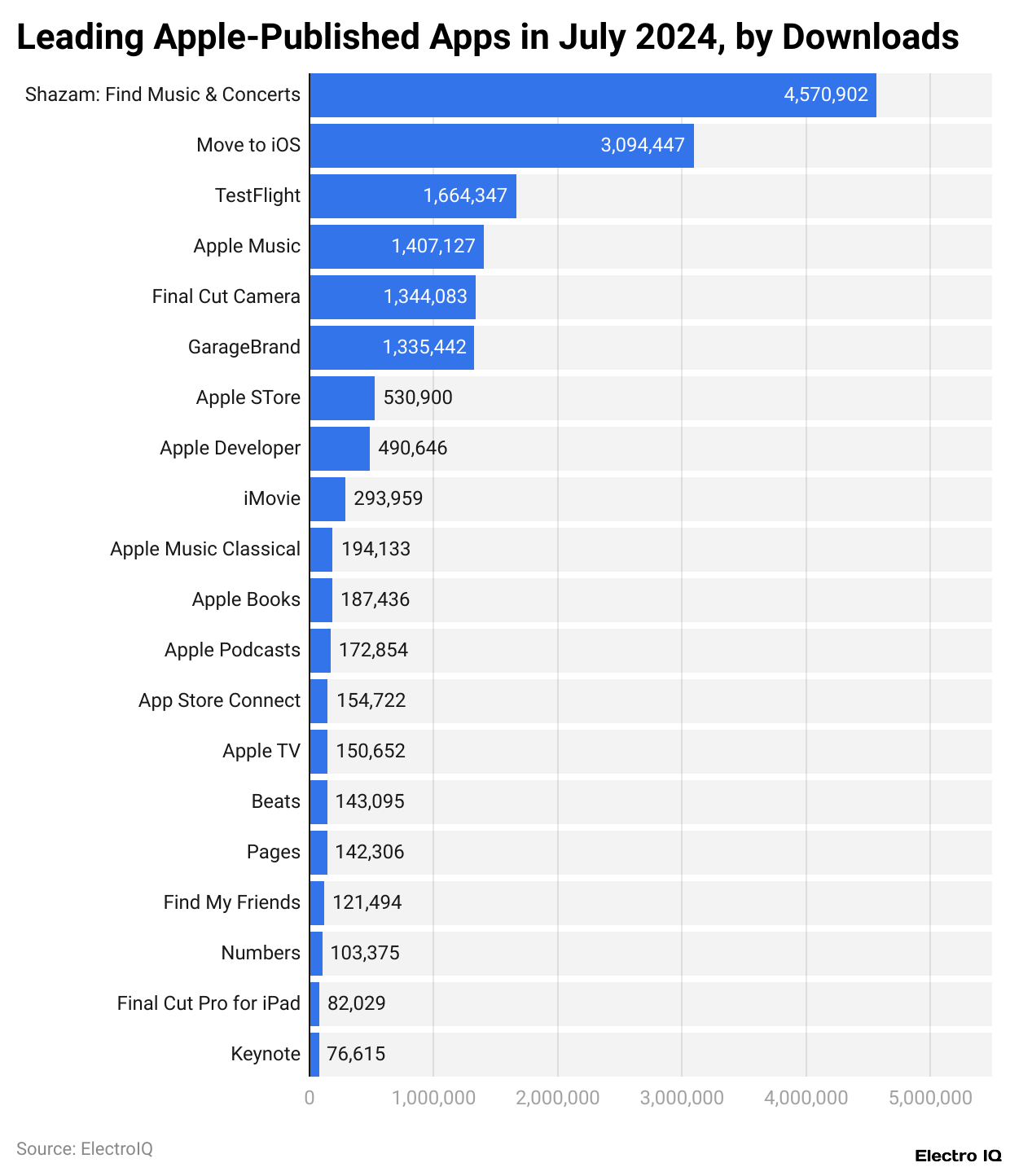
(Reference: statista.com)
- In July 2024, Shazam: Find Music & Concerts became the most downloaded Apple app, amassing 4.6 million downloads from iOS and Google Play Store users. Shazam’s continued popularity as a music discovery tool that lets users find songs and concert information quickly is reiterated here.
- With 1.40 million downloads, Apple Music came next. Move to iOS became the second-most downloaded app published by Apple, with three million downloads worldwide.
- Mostly used by Android users migrating to Apple devices, it indicates that with the growing number of people switching to iPhones, the demand for seamless migration tools remains strong.
- TestFlight, which allows developers to test beta versions of their applications before submitting them for publication on the Apple App Store, ranks third, with 1.66 million downloads.
- Its popularity proves the ever-growing number of developers working within Apple’s ecosystem for app testing and development.
- These numbers go on to further indicate Apple’s diverse niche of app presentation, ranging from general consumers to developers.
Global Audio Streaming Platforms Service Subscription Search
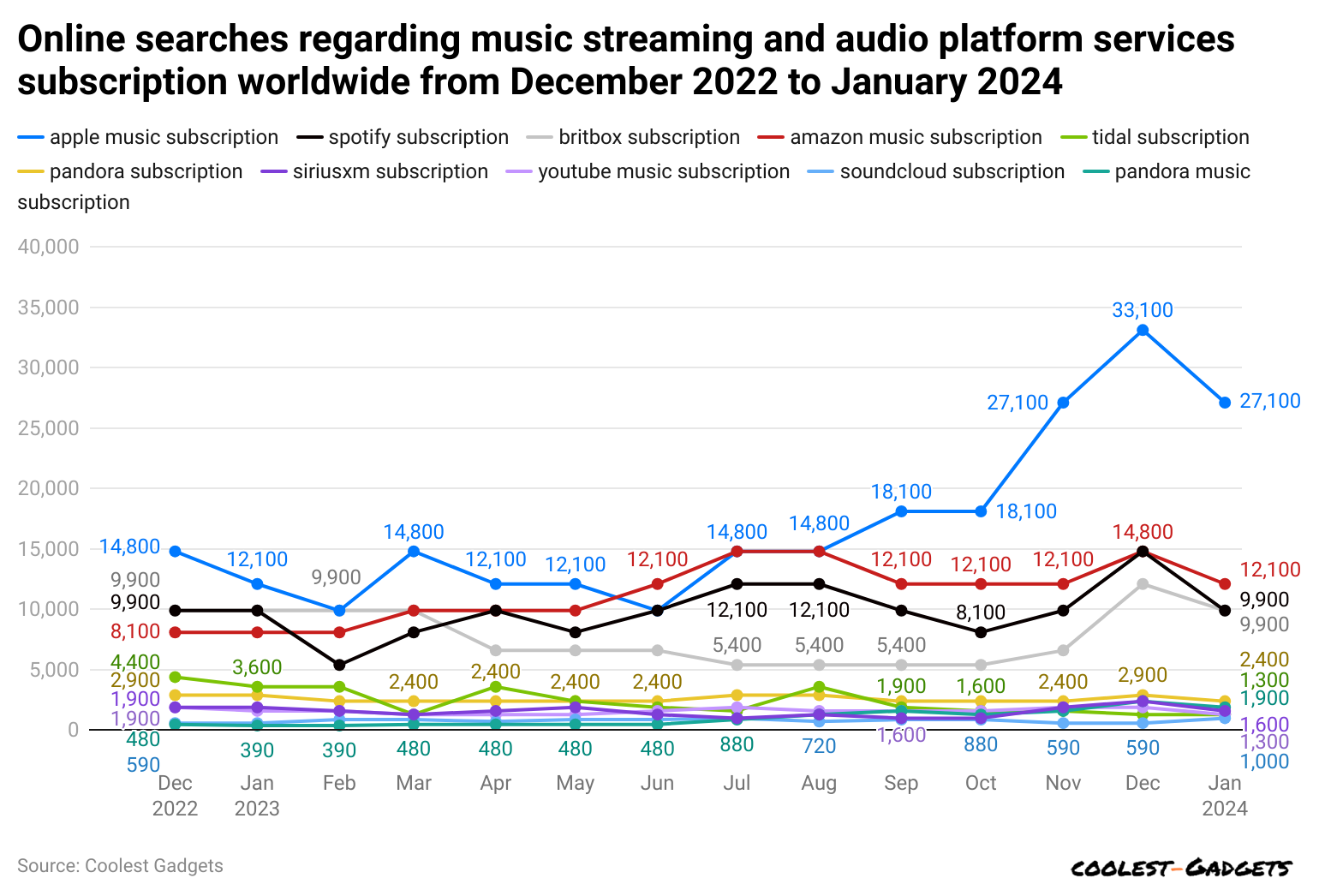
(Reference: statista.com)
- In July 2023, the keyword “Apple Music subscription” received about 60,500 global searches, demonstrating users’ strong interest in Apple Music’s offerings.
- Apple Music-related keywords have maintained the status of most searched among all queries related to music subscriptions from December 2022 until the end of January 2024, evidencing a steady demand and curiosity toward the platform.
- Other popular searches included subscriptions to Amazon Music and Spotify, highlighting the competitiveness of those entities in the music streaming industry.
- Apple Music statistics indicate that it has attained notable online visibility, with growing user interest in digital music services.
Apple Music Global Subscribers
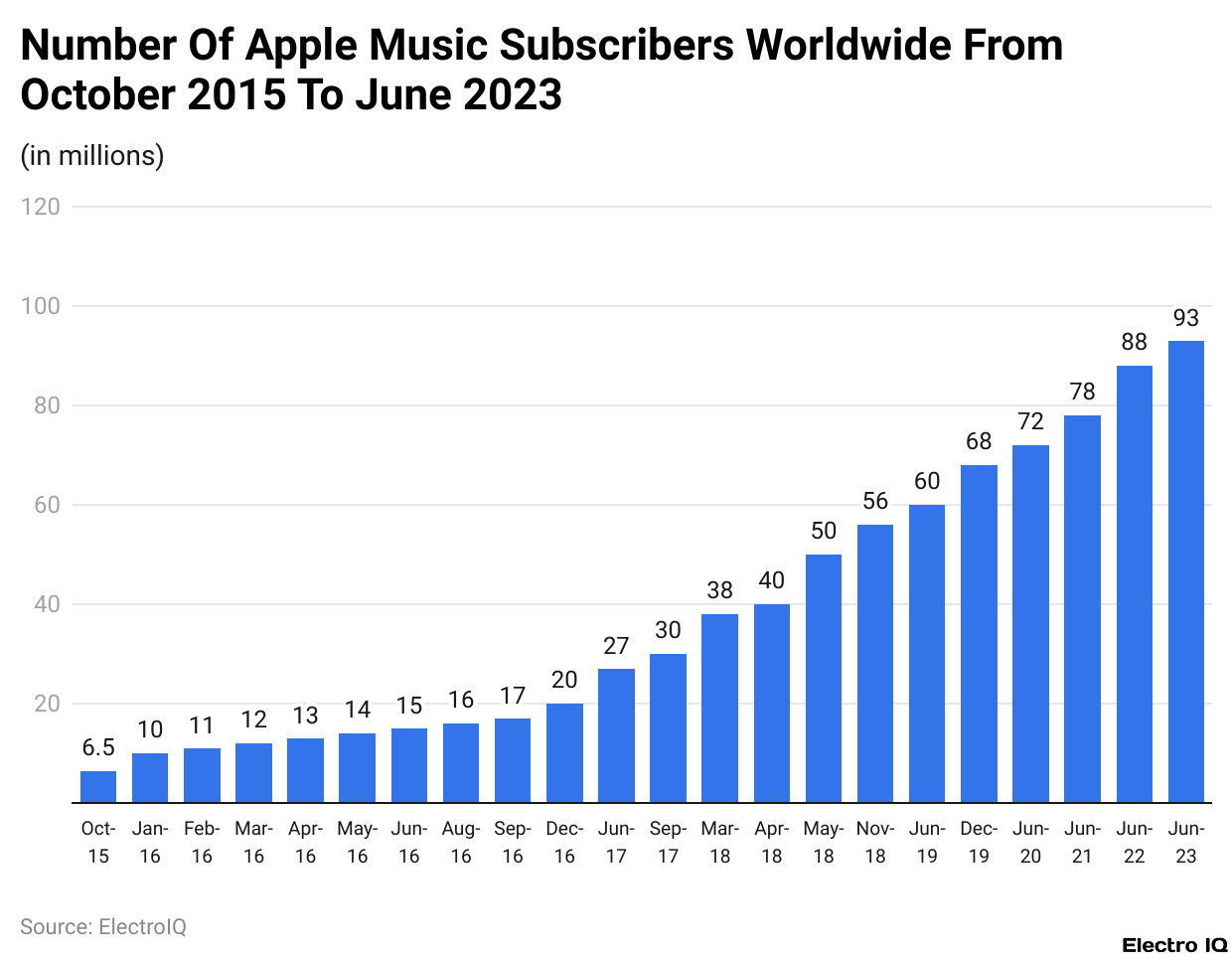
(Reference: statista.com)
- Apple Music statistics show that as of June 2023, Apple Music had approximately 93 million subscribers worldwide, an increase of 5 million in one year.
- Launched in 2015 by the U.S. tech giant Apple, the platform has quickly risen to become the second-largest music streaming service in the world and is an important rival of market leader Spotify.
- While Apple Music commands a good market share, Spotify is still a leading player, having a 35 % share of global subscribers, leaving Apple Music with only about 19 %.
- In terms of revenue, the disparity is enormous; in Q3-2020 alone, Spotify made 1.7 billion euros in global revenues on Premium accounts.
- The overall music streaming industry witnessed fulfilling growth in the last ten years. Between 2018 and 2019 alone, the streaming revenue grew by an astonishing 22.9 %, establishing it as the topmost source of income for the music industry.
- By 2019, music streaming revenue had reached 11.4 billion US dollars across the globe. The COVID-19 pandemic was an extra catalyst that advanced the rise in digital consumption of music, with further growth expected in the year 2020 and 2021.
Popular Online Music Brands
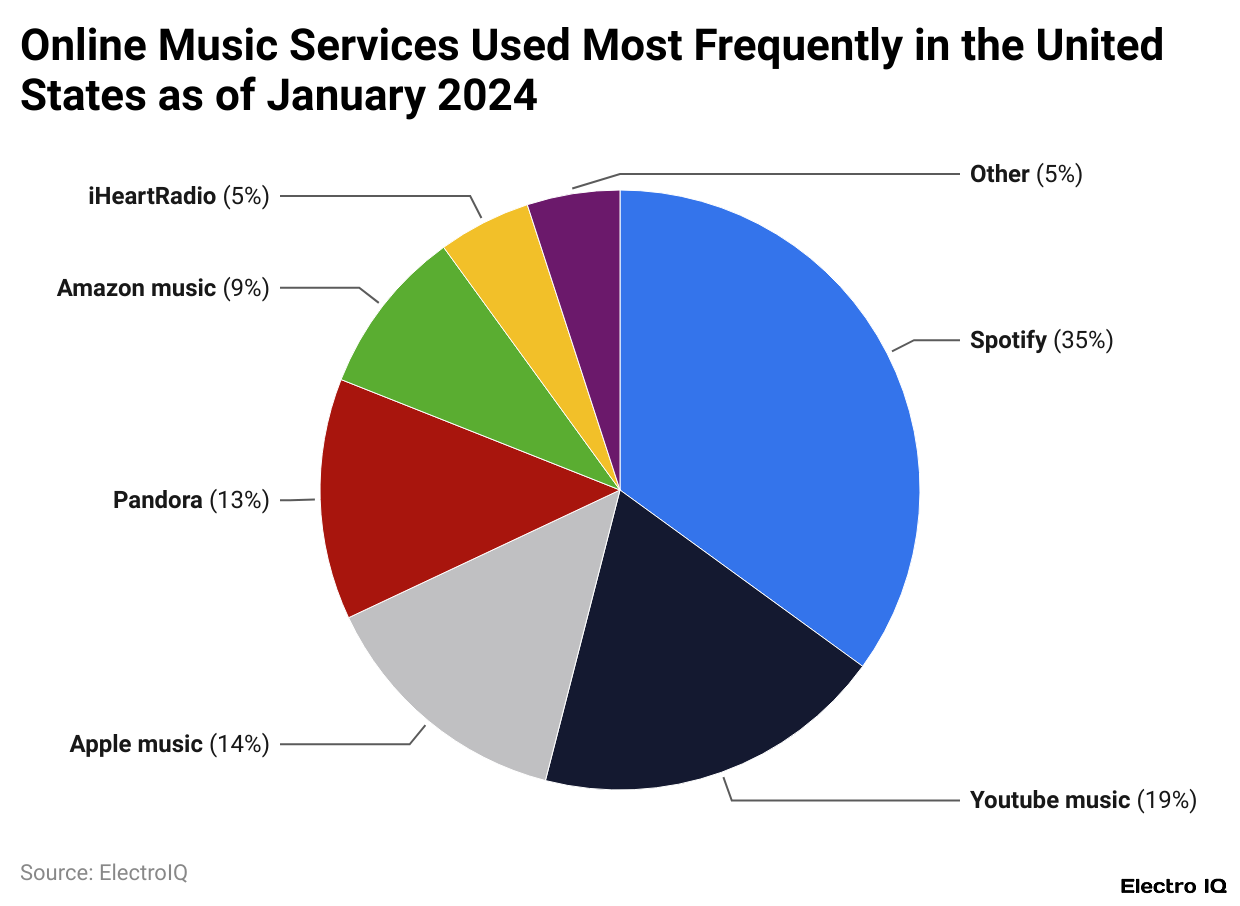
(Reference: statista.com)
- In 2023, out of that total, 35% of respondents reported having recently listened to Spotify, making it the most utilised online music service in the United States.
- YouTube Music occupies the next spot, with 19% of users stating that they had used this service in the period prior to the surveys. At the number three spot, Apple Music boasts 14% of respondents who claimed to have listened to it.
- Pandora and Amazon Music had fewer users (13% and 9%) of survey respondents who used them in the last month, respectively.
- Apple Music statistics demonstrate how hardcore yet competitive this arena is at the cut-throat world of music streaming, with Spotify maintaining a good foothold while other services draw major %ages of competitive user bases.
Apple Music Users By Country & Region
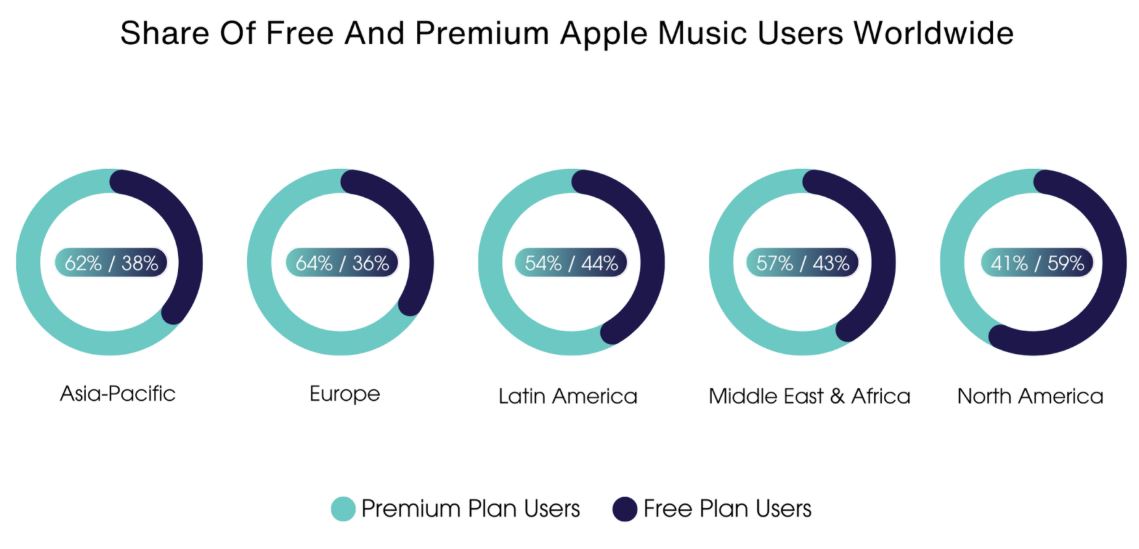
(Source: demandsage.com)
- Apple Music statistics show that the regional usage of Apple Music varies, with those around the globe having different distributions of members between Premium and Free plans.
- In Asia-Pacific, 38 % of its users subscribed to the Premium plan, while the Free plan was taken by 62%. A similar trend is observed in Europe, where 36% have the Premium, while the Free plan is taken by 64%.
- Latin America seems to be slightly better in terms of the %age of paid subscribers, as the region has 44% of its users on the Premium plan and 56 % using the Free version. In the split Middle East and Africa, Premium and Free users represent an even 43% share each.
- North America tops the chart in the region, with 59% of its users on the Premium plan and 41% using the Free version; hence, the data show consumer behavior variation across regions, purchasing power, and general adoption of paid music streaming services.
Apple Music’s Most Streamed Artist
| Music Artist |
Total Streams
|
| Taylor Swift | 70,283,780 |
| Ed Sheeran | 61,395,659 |
| Drake | 47,486,774 |
| Billie Eilish | 41,794,248 |
| Post Malone | 36,750,165 |
| The Weeknd | 35,289,031 |
| Dua Lipa | 33,883,940 |
| Ariana Grande | 33,056,730 |
| 周杰伦 | 29,716,056 |
| Bad Bunny | 28,537,029 |
| Harry Styles | 25,671,037 |
| Olivia Rodrigo | 19,732,064 |
| Justin Bieber | 19,277,137 |
| BTS | 18,964,903 |
| Travis Scott | 18,498,131 |
(Source: demandsage.com)
- According to Apple Music statistics, Taylor Swift turns out to be the most-streamed artist on Apple Music, miles ahead: T-Swift’s quite impressive 70,283,780 streams marked her out massively among a host of dedicated users worldwide.
- Closely up was Ed Sheeran, with such great attrition numbers as 61,395,659, more firmly placing him amongst the top-three most listened-to artists.
- After him is Drake, who enjoyed exceeding 47,486,774 streams and so is still carving to continue holding that influence in the music scene today.
- Popularity did not skip the likes of Billie Eilish and Post Malone, who stormed through with 41,794,248 and 36,750,165 streams, respectively; whereas The Weeknd had around 35,289,031 streams.
- Dua Lipa and Ariana Grande seemed high on charts with an excess of 30 million streams: 33,883,940 and 33,056,730, respectively, they still show that they are very much alive.
- An eminent Mandopop artist mashed 29,716,056 streams, which says much about his international outreach.
- Bad Bunny, one of the names in dictating the landscape of Latin music, took home 28,537,029 streams, showcasing the drawing power of reggaeton and Latin music to a worldwide audience.
- Harry Styles was next with almost 26 million streams or somewhat less than that, while Olivia Rodrigo, the reigning queen of the charts, managed an impressive 19,732,064 streams.
- Justin Bieber is closely following with 19,277,137. BTS-K-pop, in its most popular expression, gathered 18,964,903 streams, which is a testament to its continued popularity.
- Travis Scott was last with 18,498,131, maintaining a strong position within hip-hop and rap. It nicely reflects just how diverse the music is that responds to them, as well as how rich the category of artists who dominate this platform is.
Apple Music Business Statistics And Facts
- Apple Music statistics state that, as Apple Music strives to become more universal, the expansion to countries that have never had access is increasing rapidly.
- To entice more customers, Apple launched Apple Radio to piggyback on a 24-hour channel streaming music videos entirely, thus offering diverse content. Further, through its new launch Apple Music Lossless, users can experience CD-quality music, thus enhancing the overall listening experience.
- Apple Music and other services continued to reach new milestones when, in 2020, Apple announced making that platform available in an additional 52 countries. This announcement also expanded other Apple services, including the App Store, Apple Arcade, Apple Podcasts, and iCloud, to 20 more nations.
- This growth meant that Apple Music is now more available across Africa, the Middle East, the Caribbean, and Europe, making it truly global.
- Although there is an increasing preference for on-demand streaming, live radio remains an area of focus for Apple Music. This was done by rebranding the station from Beats 1 Radio to Apple Music 1, thereby integrating it into Apple Music Radio as an alternative experience that was supposed to be available in that service.
- According to Apple Music statistics, strengthening human interaction with algorithmic playlists and charts would better fortify the network.
- Apple believes that merging live radio is a way of building that connection between fans and artists by providing behind-the-scenes context about songs and creating audience environments akin to Instagram Live and TikTok.
- Apple Music seized the opportunity to promote Neil Young’s music after he quit Spotify. He listed his demands for the removal of his music from the platform with the exception of his protest against Joe Rogan’s content on COVID-19.
- Apple advertised his music very widely on its platform while calling itself the home of Neil Young and dedicating a section to highlight his latest album on its homepage.
- Not all Apple headphones can boast this feature, despite the introduction of Apple Music Lossless, which offers high-resolution, CD-quality audio free from additional costs. Even top-end, high-cost models like the AirPods Max cannot deliver lossless audio.
- Users who want to take full advantage of this feature need to ensure they have equipment that is compatible with the enhanced sound quality.
- Apple Music has also entered the music video streaming market and opened its own dedicated channel, similar to MTV. This channel runs 24 hours a day, showing music videos from leading artists.
- It also boasts other features such as countdowns, exclusive premieres, curated blocks, interviews, and live events.
- The programming is in the same spirit as Apple Music Radio but focuses on video content for another aspect of subscribers being engaged with their preferred music.
Apple Music Users By Age
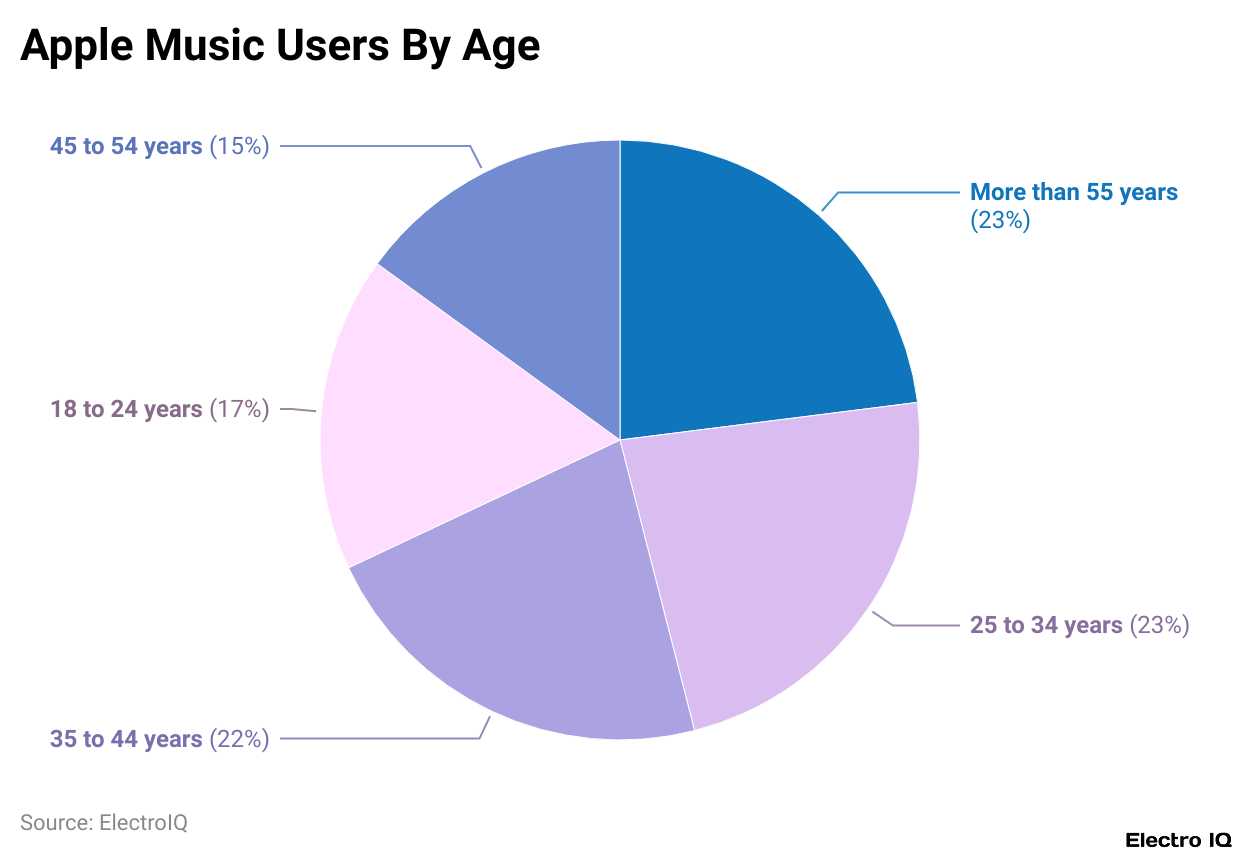
(Reference: coolest-gadgets.com)
- Apple Music statistics state that Apple Music has diversified user groups across ages. Most users belong to the largest cohorts, 25 to 34 years of age and 55 and above, each constituting 23% of the audience.
- Accordingly, both young adults and older listeners derive value from the platform, either by discovering new tracks or by enjoying old classics.
- Of the audience, 22% consisted of users between 35 and 44 years old, showing that this demographic also engages heavily with the service.
- Users aged 18-24 constitute 17% of the streams, meaning that while younger listeners are still using the platform, they may be looking elsewhere for music streaming services.
- The age group between 45 and 54 earns the smallest share, with 15% of Apple Music users. In short, the data shows that Apple Music has usage across all age ranges, drawing listeners from various generations.
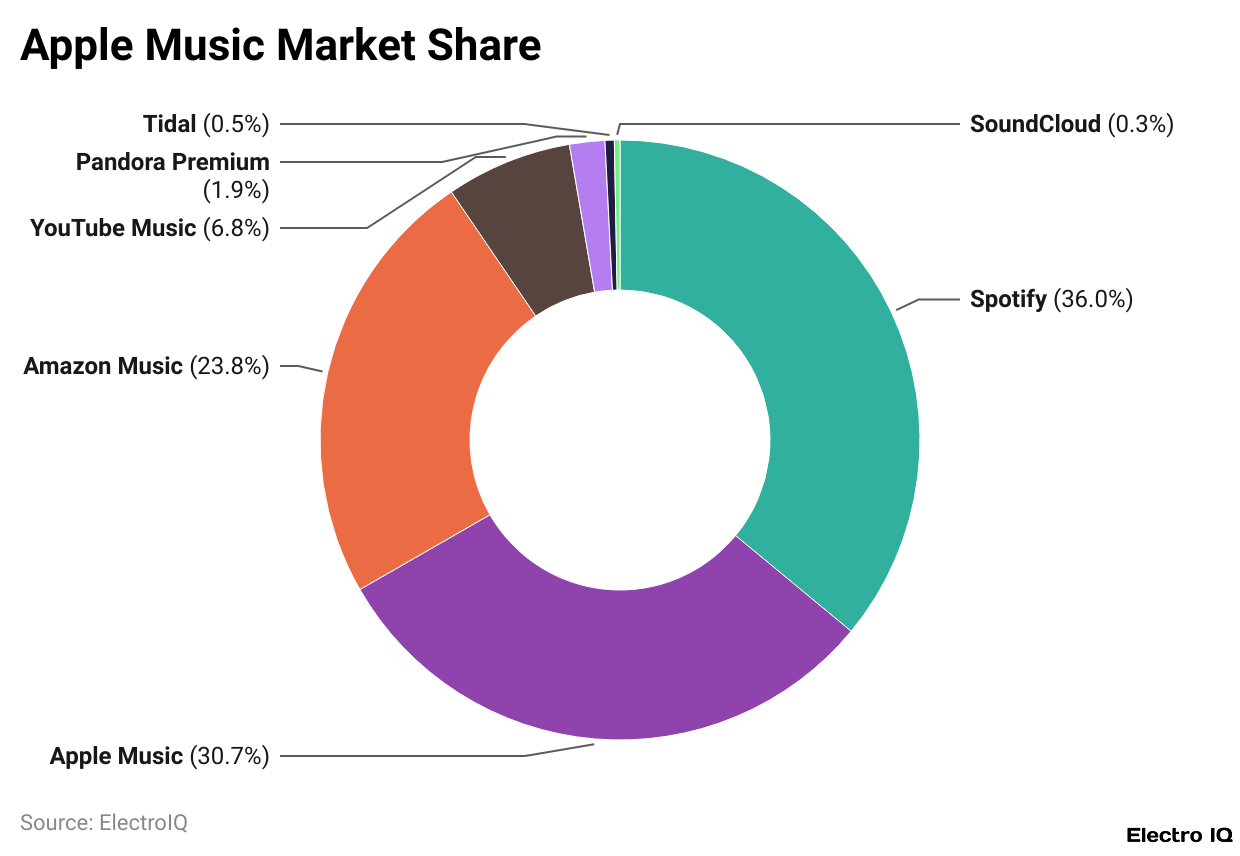
(Reference: demandsage.com)
- Spotify is the largest player in the music streaming market, accounting for 36% of all subscribers. This makes it the giant among all music streaming platforms because it has an extensive catalog, really personalised playlists, and a strong global brand.
- Apple Music statistics reveal that it is the closest competitor with 30.7%, a pointer to its greater appeal to users of Apple devices. It offers high-quality audio, exclusive content, and a Well-Integrated ecosystem.
- Followed by Amazon Music at 23.8%, it has grown to the third most popular streaming service due to its synergy between Amazon Prime and Echo devices, which has helped bind so many users into its net. It is not only through the paid subscription service.
- Most YouTube Music users stream music for free; however, only 6.8% complement their viewing with a subscription. This means that many have loved YouTube’s music, but quite a few would love to pay for it.
- Pandora Premium accounts for 1.9% of the market, targeted at a niche audience within the United States and offering streaming.
- Tidal has only 0.5% market share, which reflects its comparatively smaller user base, plus subscribers, but is very much known for high-fidelity audio and an artist-friendly revenue model.
- SoundCloud commands a minuscule 0.3% of market share as it is meant more as a platform for budding musicians than for popular streaming.
Conclusion
As per Apple Music statistics, Apple Music’s progress as a global music streaming market would unfold. The increasingly growing base of subscribers, considerable generation of revenue from the service, and continuous empowerment of features would strongly establish the service as a leader in the segments of the market.
Further, its high-definition audio fidelity, fair compensation for artists, and innovative and advanced user engagement tools would solidify its continued success in and influence on the future shaping of music consumption.
Sources
FAQ.
Last June, Apple Music officially had approximately 93 million subscribers, thus being the second-largest music streaming platform in the world, second only to Spotify.
Apple Music, trailing only behind Spotify’s 36%, has 30.7% of the total market, while Amazon Music records 23.8% and YouTube Music captures a mere 6.8%.
Taylor Swift was the most streamed artist on Apple Music, having garnered up to 70 million streams, followed by Ed Sheeran and Drake.
Apple Music did quite well, continuing its growth trajectory since it made US$9.2 billion in 2023 as compared to the US$1.7 billion earned in 2016.
Age 25-34 years and the over 55’s are the largest user groups, both representing 23% of the total audience.

Joseph D'Souza founded ElectroIQ in 2010 as a personal project to share his insights and experiences with tech gadgets. Over time, it has grown into a well-regarded tech blog, known for its in-depth technology trends, smartphone reviews and app-related statistics.





